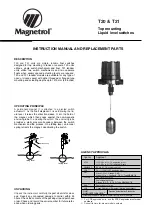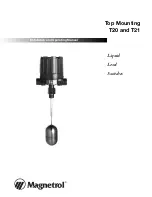
Configuring Device Information
285
•
LAG State
— Current STP state of a LAG. If enabled, the LAG state determines what forwarding action
is taken on traffic. If the bridge discovers a malfunctioning LAG, the LAG is placed in the
Broken
state.
Possible LAG states are:
–
Disabled
— The LAG link is currently down.
–
Blocking
— The LAG is blocked and cannot be used to forward traffic or learn MAC addresses.
–
Listening
— The LAG is in the listening mode and cannot forward traffic or learn MAC addresses.
–
Learning
— The LAG is in the learning mode and cannot forward traffic, but it can learn new MAC
addresses.
–
Forwarding
— The LAG is currently in the forwarding mode, and it can forward traffic and learn
new MAC addresses.
–
Broken
— The LAG is currently malfunctioning and cannot be used for forwarding traffic.
•
Role
— Displays the port role assigned by the STP algorithm to provide to STP paths. The possible field
values are:
–
Root — Provides the lowest cost path to forward packets to the root switch.
–
Designated — Indicates the port or LAG through which the designated switch is attached to the LAN.
–
Alternate — Provides an alternate path to the root switch from the root interface.
–
Backup — Provides a backup path to the designated port path toward the Spanning Tree leaves.
Backup ports occur only when two ports are connected in a loop by a point-to-point link, or when a
LAN has two or more connections connected to a shared segment.
–
Disabled — The port is not participating in the Spanning Tree.
•
Path Cost (1-200000000)
— Amount the LAG contributes to the root path cost. The path cost is adjusted
to a higher or lower value, and is used to forward traffic when a path being rerouted. The path cost has a
value of 1 to 200000000. If the path cost method is short, the LAG cost default value is 4. If the path cost
method is long, the LAG cost default value is 20000.
•
Default Path Cost
— When selected, the LAG path cost returns to its default value.
•
Priority
— The priority value of the LAG. The priority value influences the LAG choice when a bridge
has two looped ports. The priority value is between 0-240, in increments of 16.
•
Designated Bridge ID
— The bridge priority and the MAC Address of the designated bridge.
•
Designated Port
ID
— The port priority and interface number of the designated port.
•
Designated Cost
— The cost of the designated bridge.
•
Forward Transitions
— The number of times the
LAG State
has changed from the
Blocking
state to a
Forwarding
state.
Summary of Contents for PowerConnect 54 Series
Page 1: ...w w w d e l l c o m s u p p o r t d e l l c o m Dell PowerConnect 54xx Systems User Guide ...
Page 22: ...22 Introduction ...
Page 64: ...64 Using Dell OpenManage Switch Administrator ...
Page 214: ...214 Configuring System Information ...
Page 343: ...Configuring Device Information 343 ...
Page 344: ...344 Configuring Device Information ...
Page 381: ...Viewing Statistics 381 ...
Page 382: ...382 Viewing Statistics ...
















































